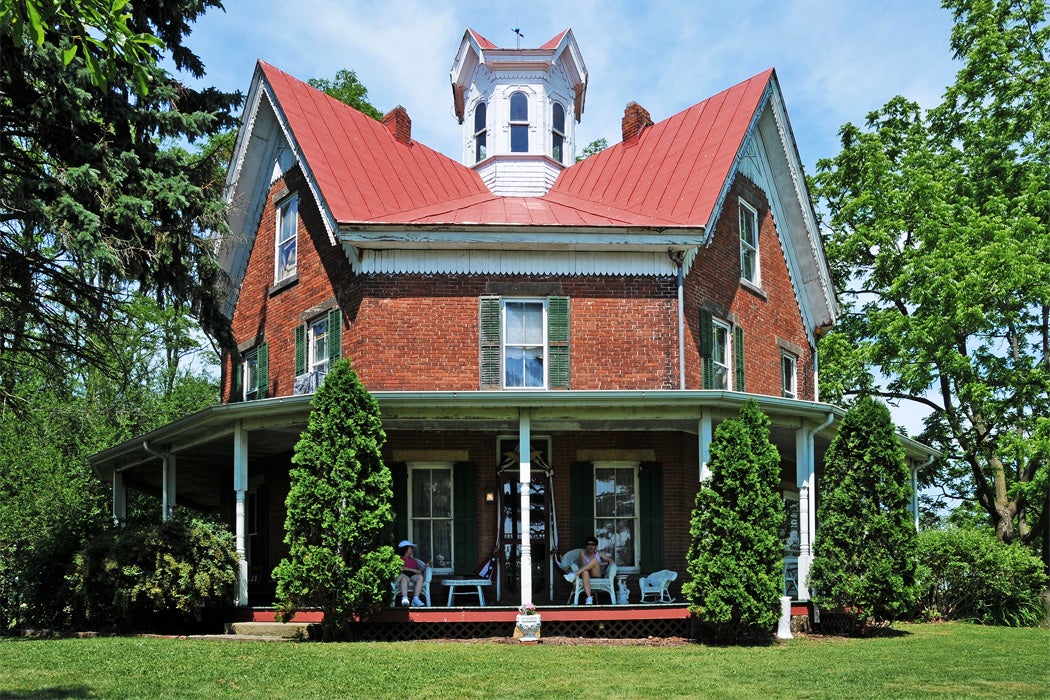Could a house without right angles offer a better quality of life? In the 1850s, leading phrenologist Orson S. Fowler turned the same attention he’d given to analyzing the measurements of the human skull to analyzing the shape of the American house. He imagined a more fluid form would be more efficient. And since a circle was difficult to build with lumber, he settled for an octagon.
Fowler was a New Yorker, born in 1809 in Steuben County, and many of the homes based on his designs are in the Northeast. It was also in New York that he established the Fowler Phrenological Institute, where he conducted cranial examinations and curated a museum packed with skulls. He amassed a large, receptive audience through his phrenological publications, which often focused on self-improvement and reform. It was from that perspective that he envisioned the octagon house. In 1848 he published Home for All: or, A New, Cheap, Convenient, and Superior Mode of Building. He soon put these concepts into practice on his own eight-sided home in Fishkill.
“For many reasons, Fowler considered the circle as found in nature to be the ideal form, far superior to the constraints found in the square or rectangle,” explains historian James Hughes in New York History. Fowler wrote that the “spherical is more beautiful than the angular, and the smooth and undulating more beautiful than the rough and projecting.” According to Fowler, an octagon’s advantages included increased floor space and a larger wall area for windows. He argued that fewer corners would save time in carrying out daily chores and tasks. Other advantages were less tangible, such as an improved “interchange of friendly and benevolent feeling,” particularly when applied to schools and churches.
On a Midwestern lecture tour, Fowler encountered gravel wall construction, which involved an early form of poured concrete. Fowler ended up promoting it as a cheaper, more durable method than boards, especially as gravel was almost always available. He also suggested triangular closets, basement kitchens, and then-novel sanitary features like running water.
Architectural historian Rebecca Lawin McCarley writes:
Introduced to the Midwest by Orson Fowler and his reform-minded followers, spread by the cultural influence of migrating Northeasterners, and enhanced by a housing boom and an expanding population who often looked to pattern books and popular journals for ideas, the octagon house proliferated throughout the Midwest in the 1850s and 1860s… Octagon builders believed in the benefits of the form, but individual builders often adapted the plan, exterior features, and size of the structure to suit their needs, resulting in uniquely different houses with an underlying common idea.
McCarley adds that it’s hard to pinpoint the exact number of Fowler-inspired buildings, although “approximately 560 historic examples have been identified, both extant and demolished.” Some were brick, some wood, some cobblestone. Some were houses, others were schools, barns, and churches. They were often built by progressive thinkers: The Hyde House in Mumford, New York, was owned by spiritualists Julia and Erastus Hyde; the Jacob Woodruff House in Ripon, Wisconsin, was constructed by a member of the Wisconsin Phalanx communal socialist society.
Once a Week
Fowler’s own Hudson River Valley house spanned sixty rooms and stood a towering four stories. However, it was only his home briefly. “Battered by the economic recession of 1857, Fowler rented the building to a New Yorker who turned it into a boarding house,” writes scholar Dwight L. Young in The Wilson Quarterly:
The following year a number of the boarders were struck down by an outbreak of typhoid, probably caused in part by cesspool seepage through the gravel walls of which Orson had been so proud. He sold the house in 1859. Over the next four decades it passed through many hands, gradually falling into ruin. In the summer of 1897 it was finally demolished.
Other architects attempted to disrupt the reign of the right angle, such as Buckminster Fuller with his round Dymaxion House. Concerns over building a healthier architecture endure, with conditions like sick building syndrome attributed to poor ventilation. The octagon house, however, has yet to return as a solution to better living. Fowler died in 1887, and he rests in an unmarked grave in the Bronx’s Woodlawn Cemetery.







